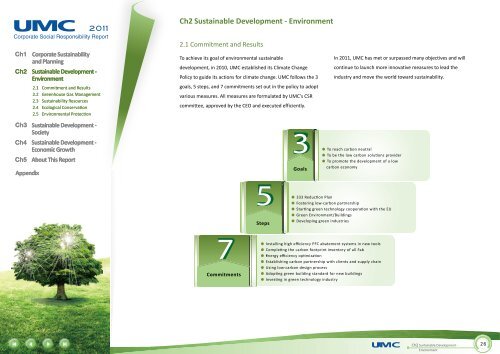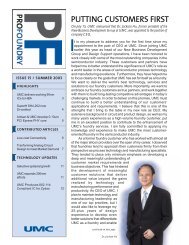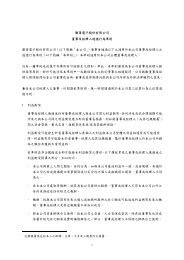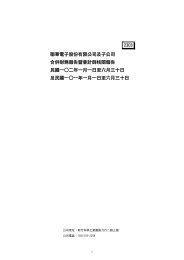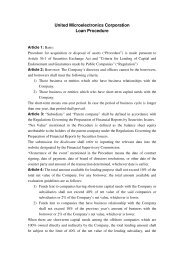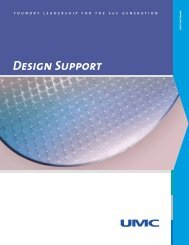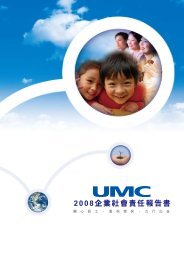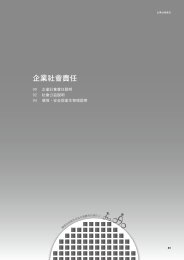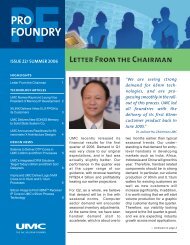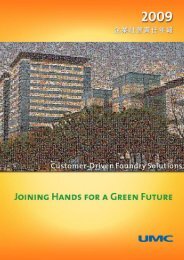Ch2 Sustainable Development - Environment - UMC
Ch2 Sustainable Development - Environment - UMC
Ch2 Sustainable Development - Environment - UMC
- No tags were found...
Create successful ePaper yourself
Turn your PDF publications into a flip-book with our unique Google optimized e-Paper software.
<strong>Ch2</strong> <strong>Sustainable</strong> <strong>Development</strong> - <strong>Environment</strong><br />
2.1 Commitment and Results<br />
To achieve its goal of environmental sustainable<br />
development, in 2010, <strong>UMC</strong> established its Climate Change<br />
Policy to guide its actions for climate change. <strong>UMC</strong> follows the 3<br />
goals, 5 steps, and 7 commitments set out in the policy to adopt<br />
various measures. All measures are formulated by <strong>UMC</strong>’s CSR<br />
committee, approved by the CEO and executed efficiently.<br />
In 2011, <strong>UMC</strong> has met or surpassed many objectives and will<br />
continue to launch more innovative measures to lead the<br />
industry and move the world toward sustainability.<br />
26
2011 Agenda Progress<br />
27
2.2 Greenhouse Gas Management<br />
2.2.1 333 Reduction Plan<br />
To achieve its goal of environmental sustainability and implement<br />
its Climate Change Policy, <strong>UMC</strong> launched the 333 Reduction Plan<br />
in 2010, which sets the reduction targets from 2010 to 2012, to<br />
guide further carbon reduction.<br />
Product Carbon Footprint Source and Reduction Measures<br />
According to the data in past years, the following two resources<br />
account for 90% of <strong>UMC</strong>’s overall emission of greenhouse gases.<br />
Introduction<br />
● Objectives<br />
Reduction targets of 33% for normalized per fluorinated<br />
compounds (PFC) emissions by 2012.<br />
Reduction targets of 3% for electricity usage by 2012.<br />
The base year is 2009.<br />
Achievements in 2011<br />
● Reduction Plan Introduction<br />
According to the product carbon footprint and greenhouse gas<br />
emissions inventory results, the major contributor of <strong>UMC</strong>’s<br />
product carbon footprint is manufacturing, with the major<br />
sources being electricity and PFC gas. <strong>UMC</strong> has thus formulated<br />
plans to reduce electricity consumption and PFC emissions in<br />
order to reduce carbon footprint.<br />
● PFC Reduction Target and Plan<br />
<strong>UMC</strong> established its "PFC Emissions Reduction Team" in<br />
1999 to implement its PFC reduction plan. <strong>UMC</strong> also set PFC<br />
reduction targets to meet the reduction target of the Taiwan<br />
Semiconductor Industry Association (TSIA) in 2010. In addition,<br />
<strong>UMC</strong> has developed its second-phase PFC reduction plan from<br />
2010 to 2012. The new plans include reduction targets of 33%<br />
for normalized PFC emission by 2012.<br />
Note: TSIA has targeted PFC emission reduction by “10% in 2010 compared to 1998<br />
(the emission of 1998 is the MMTCE average of 1997 and 1999) levels.”<br />
<strong>UMC</strong>’s PFC Emissions Intensity<br />
Accumulated Electricity Reduction<br />
28
● Major elements of the PFC emission reduction plan include:<br />
•Continue researching and testing substitute gases in<br />
semiconductor thin film process to lower the emission<br />
volume of greenhouse gases<br />
•Measure the utilization rate of machines that use PFCs and<br />
the reduction rate of the treatment equipment to master<br />
the efficiency of machines and hence conduct improvement<br />
measures toward inefficient machines<br />
•Conduct individual usage evaluation for each machine that<br />
uses PFCs to better understand greenhouse gas emissions for<br />
each machine<br />
•Carry out evaluation of adoption of new PFC abatement<br />
systems<br />
•Meanwhile, in order to lower the PFC emissions year by year,<br />
<strong>UMC</strong> plans to install high efficiency PFC abatement systems<br />
after fully evaluating all new models<br />
PFC Reduction Plan<br />
(Achieved)<br />
Note: Millions of metric tons of carbon equivalents (MMTCE)<br />
PFC Reduction Results<br />
PFC Emissions at <strong>UMC</strong><br />
Schematic Diagram Of PFC Emission Reduction Measures<br />
Supplier<br />
Feedback<br />
Note: The calculation of PFC emissions from production adopts the Tier2b<br />
semiconductor calculation formula and parameters of IPCC 2006 and the GWP of<br />
the fourth assessment report.<br />
In October 2011, Dupont and TOPCO Scientific Co., Ltd. helped <strong>UMC</strong> achieve the target of PFC "333 Reduction Plan" with<br />
Zyron®8020 (C 4 F 8 ). <strong>UMC</strong> Fab8D was the first 8-inch plant to finish the conversion. <strong>UMC</strong>’s other facilities had then reached<br />
the target following Fab8D experience or techonology support from us. Compared with C 3 F 8 and C 2 F 6 , C 4 F 8 can reduce PFC<br />
emissisons by 80 % top. Considering the fact that industrialized countries need to meet reduction targets committed to under<br />
the Kyoto Protocol, we can find that this project has made great contribution to environmental protection and climate change<br />
mitigation, in particular. We hope that <strong>UMC</strong> can continue to pioneer in this field by using more green materials.<br />
Sam Yeh, Manager of TOPCO Scientific<br />
Co., Ltd, and Juipo Hong, Manager of<br />
DuPont Taiwan Ltd.<br />
29
2.2.2 Inventory and Verification of Greenhouse<br />
Gas Emissions<br />
<strong>UMC</strong> has established a greenhouse gas emission inventory<br />
system following the requirements of ISO 14064-1 and the<br />
Greenhouse Gas Protocol. The <strong>UMC</strong> GHG inventory includes<br />
qualitative and quantitative analysis for Scope 1 (Direct GHG<br />
Emissions) and Scope 2 (Indirect GHG Emissions), and qualitative<br />
analysis for Scope 3 (Other Indirect GHG Emissions).<br />
Scope and Method of the Greenhouse Gas Inventory<br />
<strong>UMC</strong> GHG Emission Sources<br />
● <strong>UMC</strong>’s facilities in Taiwan have passed ISO14064-1 third<br />
party verification of GHG emission amounts from 2000 to<br />
2011. Singapore’s Fab 12i also passed the verification in 2010<br />
and is arranging the next verification audit in 2012.<br />
(Taiwan area)<br />
(Singapore area)<br />
● <strong>UMC</strong> joined the GHG emissions and reductions inventory plan<br />
conducted by TSIA (Taiwan Semiconductor Industrial<br />
Association) in 2006. A greenhouse gas emission inventory<br />
system has been established and the GHG emission amount of<br />
all <strong>UMC</strong> fabs has been inventoried to keep GHG emissions in<br />
check and verify reduction results.<br />
Certificate for Passing GHGEV (Greenhouse Gas Emissions<br />
Verification) for All <strong>UMC</strong> Fabs<br />
30
2.2.3 Carbon Footprint<br />
Although <strong>UMC</strong> is not an end product manufacturer, it strives to<br />
help customers to produce green products with high quality and<br />
achieve environmental sustainability and coexistence. In order to<br />
establish the basis for <strong>UMC</strong> to further promote green products,<br />
green manufacturing processes and green design, <strong>UMC</strong> has<br />
actively implemented the Total Carbon Management Project,<br />
internal GHG emission inventory and verification, and Carbon<br />
Footprint Inventory Plan.<br />
Carbon Footprint Inventory<br />
• In the carbon footprint inventory process, <strong>UMC</strong> used product<br />
Life Cycle Assessment (LCA) to assess the greenhouse gas<br />
emissions of the primary material silicon, from refining and<br />
manufacturing through production. In addition to Scopes 1<br />
and 2 of the inventory process, Scope 3 -- Other Indirect GHG<br />
Emissions, measure emissions from the supply chain,<br />
employee business travel, product use and disposal, and<br />
external waste distribution/logistics, etc., were also<br />
measured. The major contributors of Scope 3 GHG emissions<br />
come from the supply chain.<br />
•<strong>UMC</strong> completed the foundry industry’s first reported carbon<br />
footprint and EPD (<strong>Environment</strong>al Production Declaration)<br />
verification for integrated circuit wafers produced at its<br />
facilities in 2009. Follow-up for the whole company continued<br />
in subsequent years.<br />
•<strong>UMC</strong> conducted carbon footprint inventory on its 300mm<br />
wafers at the company’s Fab 12A according to international<br />
carbon footprint standard PAS2050/ISO14067(CD) in 2010.<br />
• All <strong>UMC</strong> facilities completed carbon footprint inventory in<br />
2011. The company will build upon this achievement to help<br />
enhance the entire supply chain by vigorously implementing<br />
green supply chain programs and helping customers to<br />
produce green products that have lower impact on the<br />
environment based on Carbon footprint and EPD<br />
(<strong>Environment</strong>al Production Declaration).<br />
300mm IC wafer PCF and EPD Certificate (Fab12A)<br />
200mm IC wafer PCF and EPD Certificate (Fab8A)<br />
Carbon Footprint<br />
Carbon Footprint labeling informs consumers about the amount of GHG<br />
emitted during the products' life-cycle, from raw material procurement<br />
through manufacturing, transport, and sale and encourage them to make<br />
sustainable purchase, ultimately contributing to carbon reductions.<br />
31
2.2.4 Carbon Disclosure and Communication<br />
To address the international agenda on carbon disclosure, <strong>UMC</strong><br />
has placed management of carbon emissions, carbon disclosure<br />
and communication as its key priorities. It strives to maintain<br />
effective carbon communication and exchange domestically and<br />
internationally through various methods.<br />
32
2.2.5 LCA to go Project<br />
To fulfill its duties as a global and corporate citizen, <strong>UMC</strong> has<br />
made efforts to promote carbon disclosure and inventory by<br />
investing huge amounts of financial and human resources. In<br />
2010, <strong>UMC</strong> became, with the help from Industrial Technology<br />
Research Institute (ITRI), an official member in the FP7. It started<br />
working with 18 teams from 9 member states from the industry,<br />
government and academia to jointly develop "Boosting Life Cycle<br />
Assessment use in SMEs: development of sectoral methods and<br />
tools."With extensive experience in carbon footprint and robust<br />
supply chains, <strong>UMC</strong> is in charge of case study of carbon footprint<br />
Benefits of <strong>UMC</strong>’s LCA to go Project Progressive Goals for 2011<br />
● To complete survey on the data flow of carbon<br />
footprint among its electronics supply chain and on the<br />
calculated demand<br />
● To hold three seminars on carbon footprint<br />
● To collect primary data for simple carbon footprint calculation<br />
Objectives for 2012<br />
To develop a simple model to calculate the carbon footprint and<br />
the architectural design of a web-based software<br />
tool applications in the semiconductor industry in order to build<br />
a "carbon footprint calculator," which includes a simple universal<br />
calculation method.<br />
With <strong>UMC</strong>'s carbon footprint experience and the support of<br />
supply chain partners, our collaboration with the EU in green<br />
technology provides small and medium enterprises in Taiwan<br />
with comprehensive, tailored low carbon services and helps<br />
them acquire information on their products' carbon footprint<br />
with minimal time and resources to reduce negative impact from<br />
green trade barriers. At the same time, the results of 'LCA to go'<br />
project will promote carbon reduction and raise low-carbon<br />
competitiveness for the industry.<br />
With considerable efforts in recent years, <strong>UMC</strong> has achieved<br />
international standards in terms of green technology<br />
development and received a wide recognition among different<br />
sectors in the EU.<br />
Dr. Liang-Han Hsieh, ITRI Western<br />
Europe Office<br />
In a bid to fulfill its social responsibility as a<br />
leader in the semiconductor industry, <strong>UMC</strong><br />
participated in the 7th Framework Programme<br />
(FP7) Research Project "LCA (Life Cycle Analysis) to<br />
go," with the support of MOEA, in order to keep<br />
abreast of the latest developments on carbon<br />
footprint calculation in the EU. Working with<br />
R&D teams from 9 countries, <strong>UMC</strong> is in charge<br />
of the research of a simple Life Cycle Assessment<br />
model. The result is expected to provide significant<br />
contributions for our goal to stay align with the<br />
global trend of sustainable designs for electrical<br />
products. This marks <strong>UMC</strong>’s determination to take<br />
its responsibility while delivering strong financial<br />
performance. It is a role model for the industry, as<br />
well as for the contemporaries in Europe. <strong>UMC</strong>’s<br />
active actions demonstrate Taiwan’s commitment<br />
1.Life Cycle Assessment (LCA) provides a convenient means of quantifying and describing<br />
the interactions and targeting specific process and product investments.<br />
2."Boosting Life Cycle Assessment use in SMEs: development of sectoral methods and<br />
tools" is a sub-programme of the EU’s Seventh Framework Programme (FP7).<br />
3.The Framework Programme is the EU’s primary funding mechanism for supporting<br />
collaborative, trans-national R&D. The primary aim of the current Programme (FP7) is<br />
to strengthen the EU's Science and Technology base, improve the EU's competitiveness,<br />
and support policy development in the EU.<br />
to promote a green electronics industry.<br />
33
2.3 Sustainability Resources<br />
With the extreme weather events affecting communities<br />
worldwide, the scarcity of resources is becoming more<br />
severe. <strong>UMC</strong> recognizes that resource management is not<br />
only an environmental issue, but also involves operational<br />
risks in business as well as the welfare of mankind. Therefore,<br />
<strong>UMC</strong> continues to implement various measures for water<br />
conservation, raw materials and waste reduction, as well as<br />
recycling. By facilitating source reduction, recycling and reuse,<br />
along with other related measures, we are moving toward<br />
environmental sustainability and coexistence.<br />
The achievements made in 2011 are specified in the following<br />
sections.<br />
Furthermore, <strong>UMC</strong> promotes energy saving programs in the<br />
office and public areas accompanied with promotion activities<br />
and training to enhance employees’ ideas and habits in energy<br />
saving and greenhouse gas reduction.<br />
<strong>UMC</strong>’s Completed and Ongoing Energy-saving Projects<br />
2.3.1 Energy Management - Reduction<br />
Energy utilization consumes the earth’s resources and results in<br />
the greenhouse effect. <strong>UMC</strong>’s energy consumption mainly relies<br />
on purchased electricity, followed by a small amount of natural<br />
gas; indirect energy is not used. The largest source of <strong>UMC</strong>'s<br />
greenhouse gas emissions is from purchased electricity.<br />
Therefore, reducing energy consumption is the effective key to<br />
alleviate the environmental impact caused by the greenhouse<br />
effect. To effectively drive energy saving activities, <strong>UMC</strong> formed<br />
an energy saving committee chaired by the CEO. The committee<br />
will formulate plans, set targets, and coordinate with all<br />
departments to drive cost saving strategies and implement<br />
action plans. The committee will hold regular meetings to<br />
track schedule, verify performance, explore new energy<br />
saving technology, and develop improvement plans to achieve<br />
noteworthy energy savings. In 2010, it set the annual target to<br />
reduce electricity and gas consumption by 1% and 5.8%,<br />
respectively from 2011 to 2012 (comparison based on 2009<br />
reduction data on savings from the same facilities).<br />
To reduce energy consumption, <strong>UMC</strong> utilizes solar power to<br />
generate electricity<br />
Power Consumption Reduction<br />
● 2011 reduction target: 1% reduction compared to 2009<br />
● 2011 reduction result: achieved a reduction rate of 1.8%<br />
Note:<br />
1. Power consumption in 2011 is reduced by 1.8% compared to 2009. The<br />
comparison is based on energy reduction measures using the same equipment as in<br />
2009, and excludes factors of production fluctuations and increased consumption<br />
from new fabs.<br />
2. Energy-saving measures to save power consumption value based the theory<br />
to calculate.CO 2 emission value based on the CO 2 emission code of Taiwan Power<br />
Company = 0.612kgCO 2 e/Kwh<br />
Ongoing and Future Electricity Reduction Plans<br />
34
Natural Gas Consumption Reduction<br />
● 2011 reduction target: 5.8% reduction compared to 2009<br />
● 2011 reduction result: achieved a reduction rate of 11.2%<br />
<strong>UMC</strong>’s Completed and Ongoing Natural Gas Saving Projects<br />
Ongoing and Future Electricity Reduction Plan<br />
Note:<br />
1. Natural gas consumption in 2011 is reduced by 11.2%<br />
compared to 2009. The comparison is based on natural gas reduction measures<br />
using the same equipment as in 2009, and excludes factors of production<br />
fluctuations and increased consumption from new fabs.<br />
2. The CO 2 emission value is based on the IPCC 2006 emission<br />
factor and the natural gas calorific value used in Taiwan = 8000 Kcal/M 3 .<br />
In 2012, <strong>UMC</strong> will continue to facilitate more natural gas<br />
saving projects, including heat recovery, HDI heat pump and<br />
local scrubber projects.<br />
Boiler Waste Exhaust Heat<br />
Recycle Energy Saving Project<br />
L/S RFB Upgrade<br />
VOC Waste Exhaust Heat Recycle<br />
Energy Saving Project<br />
Heat Pump<br />
35
2.3.2 Water Resources Management<br />
Plans - Reduction and Recycling<br />
Due to global climate change, the contrast between wet and<br />
dry season discharge has become more pronounced. The<br />
development and management of water resources has become<br />
a major global concern. As for carbon footprint, water footprint<br />
is also considered important information for disclosure and<br />
management by the international community and enterprises.<br />
<strong>UMC</strong> places high priority on water resource management. In<br />
addition to formulating and implementing effective water-saving<br />
measures, in 2010, it set the annual target to reduce water<br />
consumption by 1% from 2011 to 2012 (comparison based on<br />
2009 reduction data on water savings from the same facilities).<br />
Water Footprint Verification<br />
● In 2010, <strong>UMC</strong> completed verification of product water<br />
footprint for its 8" and 12" IC wafer inventory. <strong>UMC</strong>’s water<br />
footprint results will act as a future basis for optimization of<br />
water resource utilization. Also, we found that water used<br />
directly in the company’s manufacturing processes at the<br />
current stage is greater than in the indirect supply chain, and<br />
the proportion of grey water is high. Therefore, <strong>UMC</strong> will take<br />
water footprint verification into consideration for any new fabs<br />
built. Through gathering data on the water usage impact of<br />
suppliers throughout the supply chain, we plan to collaborate<br />
on increasing the efficient use of water resources as our aim<br />
and join forces in water conservation and protecting the earth<br />
we live in.<br />
● <strong>UMC</strong> completed the water inventory and verification in 2011.<br />
We will continue to carry out the task in the future to track the<br />
effectiveness of our water conservation measures.<br />
Verification of Product Water<br />
Footprint for 8” IC Wafer Factory<br />
3 Steps to Reduce Water Use<br />
Verification of Product Water<br />
Footprint for 12” IC Wafer Factory<br />
Water Footprint<br />
Water footprint, also known as virtual water, includes blue water, green water and grey<br />
water<br />
● Blue water : the water from surface or groundwater<br />
● Green water : the water from rainfall<br />
● Grey water : the volume of water that is required to dilute pollutants to such an extent<br />
that the quality of the ambient water quality standards.<br />
Water footprint reflects the volume of water consumed during the production process. The<br />
idea is to increase understanding of the influence and consumption of water on the final<br />
product, and to help the public to see water as a “cost” in their daily life and effectively<br />
manage water use.<br />
Water Saving Measures<br />
<strong>UMC</strong>’s water conservation team (under the Energy Saving<br />
Committee), whose scope spans all fabs and departments,<br />
is responsible for planning strategies and implementing its<br />
projects:<br />
● Establish working principles to achieve water conservation<br />
results<br />
● Expand water recycling methods and reduce water<br />
consumption<br />
● Implement PDCA when integrating environmental protection<br />
goals<br />
● Achieve end-pipe management through a day-to-day<br />
management approach<br />
● Establish a wastewater treatment system and develop multiple<br />
recycling processes to maximize efficiency<br />
● Establish <strong>UMC</strong>’s water resources management system and<br />
check water balance in all fabs to confirm rationality of water<br />
usage<br />
● Establish an integrated technology committee under the<br />
facilities department, responsible for experience integration<br />
● Establish water conservation measures and directly introduce<br />
new fab construction standards<br />
36
Water Consumption Reduction<br />
● 2011 reduction target: 1 % reduction compared to 2009<br />
● 2011 reduction result: achieved a reduction rate of 3.5%<br />
<strong>UMC</strong>’s Water Conservation Result (2007-2011)<br />
Future Water Conservation Projects<br />
Water conservation will face increasing challenges in the future<br />
as fewer areas will be available to further save water. <strong>UMC</strong> will<br />
continue to introduce new technology that can help save water<br />
in a cost-effective way. <strong>UMC</strong> has set a goal to save 1% more<br />
water (about 100,000 tons of water) every year.<br />
Note:<br />
1. Water consumption in 2011 is reduced by 3.5% compared to 2009. The comparison is based<br />
on water use reduction measures using the same equipment as in 2009, and excludes factors<br />
of production fluctuations and increased consumption from new fabs.<br />
2. The equivalent CO 2 emission value is based on the formula provided by Taiwan Water Corpora<br />
tion (water supply 0.193kg-CO 2 /m 3 ).<br />
New Water Conservation Measures in 2011<br />
Note:<br />
1.Fab 12A phase 3 is newly constructed.<br />
2.Pao-Shan Second Reservoir is the main water supply to the Science Park. The total water storage<br />
capacity is 31.34 million tons (source: Water Storage Capacity Report on January 2012, WRA,<br />
MOEA).<br />
Total water recycled was 23.27 million tons, equivalent to<br />
conserving 0.7 of Pao-Shan Second Reservoir’s water storage<br />
capacity.<br />
Fab12A CMP waste water<br />
reuse facility<br />
Fab8F EPI LSR water<br />
recycle facility<br />
37
2.3.3 Material Resources Management:<br />
Material Reduction<br />
<strong>UMC</strong> aggressively promotes cleaner production and adopts<br />
state-of–the-art technology to facilitate sustainable operation<br />
and development. <strong>UMC</strong> first selects its target from raw materials<br />
that produce major waste by referring to international trends<br />
and government-controlled chemicals. Related departments will<br />
then conduct small-scale experiments to evaluate technology<br />
feasibility while reducing this target in conformance with the<br />
company’s cost-down policy and internal benchmark method. If<br />
it proves to be feasible, the reduction method will be applied in<br />
each fab.<br />
<strong>UMC</strong>’s Raw Materials Usage Reduction Result in 2011<br />
Material Management<br />
● With a raw material management e-system and regular<br />
analysis of optimum consumption by dedicated units and<br />
personnel, <strong>UMC</strong> ensures the rational procurement and<br />
utilization of material resources.<br />
● For key raw materials, <strong>UMC</strong> analyzes the correlation<br />
of production capacity and waste output with material<br />
consumption, and also implements various material usage<br />
reduction projects. Through optimizing production processes,<br />
workflow improvement and target management, <strong>UMC</strong> can<br />
reduce consumption from the source.<br />
● Management and reduction of material usage for 2008 is<br />
officially controlled by the Green Production subcommittee<br />
within <strong>UMC</strong>’s CSR committee.<br />
2.3.4 Waste Management - Reduction<br />
and Reuse<br />
Waste Reduction<br />
<strong>UMC</strong>’s 2011 waste reduction initiatives include:<br />
● Lower frequency of changing sulfuric acid for manufacturing<br />
facilities to reduce usage and waste volume of sulfuric acid<br />
● Replacing solvent cleaner with common diluted chemical<br />
solutions in some production lines, to reduce waste solvent<br />
volume<br />
● Optimization for prevention equipment of Volatile Organic<br />
Compounds to reduce waste liquid volume<br />
From Waste to Resources<br />
In addition to process improvement, <strong>UMC</strong> promotes waste<br />
recycling and reuse to replace current end pipe treatment<br />
measures to transform garbage into useful resources. This can<br />
help:<br />
● Reduce waste volume<br />
● Reduce the resources and costs of handling waste<br />
● Create revenue from recycled and reused waste<br />
Waste Recycling and Reuse List in 2011<br />
Revenue generated from recycled resources reached NTD$300 million<br />
in 2011 (Taiwan)<br />
Recycling and reuse of waste surpassed 80% in three consecutive years<br />
(2011)<br />
38
Waste disposal sequence:<br />
Reuse in <strong>UMC</strong> → Outsourcing for Reuse →<br />
Recycle as an Auxiliary Fuel→Incinerated or Landfill<br />
Implemented Reuse Measures in <strong>UMC</strong>’s Taiwan Fabs<br />
<strong>UMC</strong> Waste Recycling Rates<br />
Note:<br />
Other waste recycling methods include solidification, overseas treatment and<br />
chemical treatment.<br />
39
Plans to Turn Waste into Resources in 2011<br />
● Highly concentrated waste hydrofluoric acid reuse: <strong>UMC</strong><br />
cooperates with chemical plants to collect waste hydrofluoric<br />
acid and send it to chemical plants for recycling as sodium<br />
fluorosilicate<br />
• Benefits: lower work load for <strong>UMC</strong>’s water treatment plant<br />
and reduced volume and handling cost of Calcium Fluoride<br />
added soils<br />
● Slurry recycling and reuse: <strong>UMC</strong> is working with slurry<br />
suppliers to develop a new recycling technology which allows<br />
the supplier to make adjustment to waste slurry before reusing<br />
it in the manufacturing process<br />
• Benefits: reduced cost from reusing resources<br />
Future Plans<br />
● <strong>UMC</strong> will continue to develop new recycling technology with<br />
waste contractor/chemical suppliers<br />
2.3.5 Packaging Recycling and Reduction<br />
● <strong>UMC</strong> uses materials for shipping that fully comply with the<br />
heavy metal requirements within the EU’s PPW (Packaging and<br />
Packaging Waste) Directive<br />
● <strong>UMC</strong> uses packaging materials including recyclable materials,<br />
cartons, and non-chlorine bleaches, to minimize its<br />
environmental impact<br />
● <strong>UMC</strong> typically reuses raw material packaging and used product<br />
packaging, after obtaining clients’ agreement, to reduce<br />
packaging consumption and waste generation.<br />
2.4 Ecological Conservation<br />
To respond to global environmental challenges and conserve<br />
biodiversity, in addition to pollution prevention measures, <strong>UMC</strong><br />
has decided to promote green building and green education to<br />
fulfill its responsibility of environmental protection and ecological<br />
conservation. The decision is made upon the consideration that<br />
<strong>UMC</strong> fabs are located in a highly developed area with abundant<br />
plants and phototropic plants, as well as certain endangered<br />
wild animals in the vicinity. In addition to improving <strong>UMC</strong>’s green<br />
competitive edge, this can also help protect the environment<br />
and conserve biodiversity.<br />
2.4.1 Green Building Plans Progress and<br />
Results<br />
Progress and Results<br />
Green Building Design Features–Fab 12A<br />
● Ecological, green, water-retaining design<br />
• Applied surrounding forest landscaping to decrease impact<br />
on habitat migration<br />
• Created ecological ponds for the purpose of both flood<br />
detention and rain water reclamation<br />
• Inter-lock brick type pavement was applied<br />
• Used permeable sloping design for unexcavated areas<br />
• Replaced conventional AC pavement design for all internal<br />
access points to improve rain water retention capability<br />
Received Gold<br />
12A Green Building<br />
Certification for 12A<br />
Green Building in 2011<br />
● Energy-saving air conditioning design<br />
• Adopt VAV air conditioning systems in all offices<br />
• Applied free-cooling control mode during the winter season<br />
• A comprehensive heat pump design has been introduced<br />
across the board as a boiler auxiliary to retrieve cooling loads<br />
back to the central chilled plant for water-return. These have<br />
contributed greatly to annual natural gas conservation<br />
● Energy-saving lighting design<br />
Fab 12A P3 introduced energy-saving fluorescent lamps with<br />
low-loss electronic ballast and metal halide lamps to improve<br />
lighting controllability. These have made huge contributions<br />
to annual energy conservation with the same designed<br />
illumination.<br />
40
● Local renewable energy design<br />
For renewable energy design, we installed a solar photovoltaic<br />
system of 99.75kWp, which is connected with the electricity<br />
supply system from TaiPower Company, on Fab 12A in<br />
September 2009. By 2011, the total electricity generation from<br />
this solar photovoltaic system was 500Kwp.<br />
Green Factory<br />
<strong>UMC</strong> joined "Green Factory Promotion Association" in 2010<br />
and is working with experts from industry, government, and<br />
academia to build a green building and green factory-clean<br />
production evaluation system, aiming to establish "Green Factory<br />
Standards" in Taiwan.<br />
● 2011 Association members provided a new draft plan of EEWH<br />
green building evaluation system, and provided suggestions for<br />
a green factory-clean production evaluation system structure<br />
● 2012 objective- Fab 12A P3-4 to apply for a Green Seal<br />
recognition, following the green factory standards issued by<br />
Industrial <strong>Development</strong> Bureau, Ministry of Economic Affairs<br />
<strong>UMC</strong>’s Future Plans for Green Buildings/Factories<br />
● New fabs are designed in accordance with green building and<br />
factory design criteria<br />
● Conduct green building/factory evaluation in the construction<br />
stage of new fabs and adopt green design and features<br />
2.4.2 Green Initiatives<br />
<strong>Environment</strong>al Education within the Company<br />
● The Purchase of Green-Labelled Products for Office Use<br />
<strong>UMC</strong> implements a policy encouraging the purchase of greenlabeled<br />
products for office use, to promote green industries<br />
and reduce negative impact to the environment. <strong>UMC</strong> was<br />
awarded the green procurement prize in 2011 and continues<br />
to promote green procurement each year.<br />
<strong>UMC</strong> was awarded the green procurement prize in 2011 by <strong>Environment</strong>al<br />
Protection Administration<br />
● <strong>Environment</strong>al Protection Month<br />
<strong>UMC</strong> has dedicated to promote environmental protection and<br />
green education. Except to two-way E-multi-communication<br />
by each internal channel, <strong>UMC</strong> has executed a lot of<br />
environmental protection and saving energy related campaign,<br />
program and measures. Through employees’ practice and<br />
increasing environmental protection awareness, sustainable<br />
development and environment protection have involved into<br />
work place and employees’ life.<br />
<strong>UMC</strong> adopted the theme "Green Action, Cool Planet" to<br />
implement a series of energy-saving activities and measures<br />
in 2011, including environmental protection month, energysaving<br />
activities in the office, an environmental protection<br />
declaration for <strong>UMC</strong> employees and their family members,<br />
and others. <strong>UMC</strong> expects its employees to build environmental<br />
protection practices such as water conservation, energy-saving<br />
and resource recycling into their daily lives to reduce carbon<br />
emissions and global warming.<br />
41
● Energy-Saving Activities<br />
• Energy-Saving Leader<br />
Nominate an Energy-Saving Leader in every fab and conduct<br />
inter-plant energy management audit, to promote energy use<br />
efficiency among employees<br />
• Four energy-saving proposals received awards in 2011 Green<br />
Proposal competition<br />
<strong>Environment</strong>al Education outside the Company<br />
● Tree planting activity: "A Tree for Each, Yes I can Do"<br />
In 2011, <strong>UMC</strong> promoted low-carbon ideas (less meat<br />
consumption and elevator usage; more local produce and<br />
exercise) in line with BCSD (Business Council for <strong>Sustainable</strong><br />
<strong>Development</strong>) to enhance sustainability inside and out. More<br />
over, it also supported the United Nations International Year<br />
of Forests and invited employees to the tree-planting activity<br />
to help create a greener environment, reduce carbon, save<br />
energy and, above all, protect the earth.<br />
● School <strong>Environment</strong>al Education<br />
<strong>UMC</strong> donated power electronics laboratory equipment to<br />
the Department of Electrical Engineering at National Taiwan<br />
University (NTU). The company has also established a <strong>UMC</strong><br />
funded green energy technology seminar at NTU to research<br />
power electronics, power systems, and green electric energy.<br />
<strong>UMC</strong> provides students with resources to integrate theory<br />
and practice in their R&D experiments, as part of fostering<br />
Taiwan’s future green energy technical talent. The hope is that<br />
these actions would help cultivate Taiwan’s technical talent in<br />
green energy fields, including renewable energy sources, solar<br />
energy and energy-saving lighting such as next-generation light<br />
emitting diodes (LED).<br />
● Other school environmental education<br />
• Collaborate with universities to create a "High-tech Industry<br />
and <strong>Environment</strong>al Protection" course<br />
• Provide factory visits and practical courses for college<br />
students<br />
• Provide scholarships<br />
• Collaborate with colleges and universities on cooperative<br />
work experience education<br />
• Hold environmental and technology conference<br />
2.5 <strong>Environment</strong>al Protection<br />
2.5.1 <strong>Environment</strong> Management<br />
<strong>Environment</strong>al, Safety and Health Management<br />
As environmental, safety and health issues become diverse and<br />
significant, the GRM and ESH Division was established to be<br />
responsible for planning the company’s policies and strategies<br />
for risk management, as well as monitoring global information<br />
regarding environmental, safety and health topics. The GRM<br />
and ESH Division introduces effective systems and provides<br />
safety and health expertise to build a safe, healthy and naturally<br />
friendly environment.<br />
● Main Duties of ESH Committee<br />
• Plan and decide on company-wide strategies regarding<br />
environmental, safety and health issues<br />
• Hold a company-wide industrial safety meeting quarterly<br />
• Periodically review the results and performance of the<br />
company’s environmental safety and health operations<br />
● <strong>Environment</strong>al, Safety and Health Management System<br />
To achieve the objective of sustainable management, <strong>UMC</strong><br />
has built its environmental management system based on<br />
ISO14001 and OHSAS18001. <strong>UMC</strong> conducts a binannual<br />
internal audit in all fabs, an annual third-party audit, and<br />
sets ESH goals to improve its performance in promoting<br />
environmental protection, health, and safety.<br />
<strong>UMC</strong> calls on its employees to participate in tree planting activity for<br />
greening environment<br />
42
● <strong>Environment</strong>al Management System Overview<br />
High<br />
Management<br />
Level Audit<br />
Check<br />
Policy<br />
Improving<br />
and<br />
Plan<br />
Pollution Prevention<br />
<strong>UMC</strong>’s environmental protection policy explicitly sets the goal<br />
of zero pollution and the mandate to comply with or exceed<br />
environmental regulation requirements or international<br />
standards, in an attempt to become a sustainable green<br />
enterprise. <strong>UMC</strong> has installed various effective pollution control<br />
equipment and a 24-hour central monitoring system. It continues<br />
to conduct annual pollutant tests and builds a dedicated<br />
pollution prevention team pursuant to applicable regulations.<br />
The team is in charge of pollution management and monitoring<br />
to ensure the proper functioning and performance compliance<br />
of all pollution control equipment.<br />
Management Focus in 2011<br />
● Acute Biological Toxicity in Waste Water<br />
Due to the increased awareness of environmental issues and<br />
the enforcement of government regulations, the control of<br />
biological toxicity in effluent water has become a new area of<br />
concern. <strong>UMC</strong>'s pursuit of sustainability motivates it to join<br />
Hi-tech Waste Water Discharge Standards Functional Group<br />
made up by Hsinchu Science Park Administration, various<br />
industrial associations, and Science Park Association. The group<br />
members have conducted evaluations on factors that could<br />
contribute to acute biological toxicity, including NH 3 , TMAH,<br />
H 2 O 2 , electricity conductivity, nano or other substances. <strong>UMC</strong>’s<br />
main task is to conduct an improvement assessment of TMAH,<br />
which is scheduled to finish in 2011. The results will be sent to<br />
Science Park Administration and Functional Group to facilitate<br />
appropriate control measures. <strong>UMC</strong> has built a task force to<br />
minimize the acute biological toxicity in waste water. The task<br />
force focuses on raw materials, pipe diversion, and end-ofpipe<br />
treatment technology. Its effort includes identifying the<br />
toxicity profiles for raw materials, purchasing water quality<br />
testers, identifying sources of waste water toxicity, setting up<br />
a laboratory for daphnia toxicity tests, conducting an analysis<br />
for key factors of biological acute toxicity and a toxicity test on<br />
effluent water, and evaluating the treatment equipment for<br />
biological acute toxicity key factors.<br />
●Waste Contractor Audit Plan<br />
All of <strong>UMC</strong>’s waste is outsourced for treatment by contractors.<br />
In addition to selecting a qualified contractor and best<br />
treatment method, <strong>UMC</strong> also established an annual audit plan<br />
for its waste contractors and conducts regular audits in the<br />
treatment plant.<br />
43
<strong>Environment</strong>al Management Statistics<br />
44
<strong>Environment</strong>al Management Statistics<br />
45
2.5.2 Product Management<br />
Life Cycle Assessment (LCA)<br />
LCA is a tool to improve products and manufacturing process<br />
and reduce pollution. It helps decision makers to become<br />
involved with more environmental aspects. The steps to<br />
conduct LCA includes: Scope Definition, Inventory Analysis,<br />
Impact Assessment, and Result Interpretation. In 2005, <strong>UMC</strong><br />
authorized the Industrial Technology Research Institute (ITRI)<br />
to implement a Life Cycle Assessment in each fab. The results<br />
of such an assessment would help <strong>UMC</strong> to meet the Ecological<br />
Design Directive (ErP Directive) vis-à-vis its products, understand<br />
the impact on the environment caused by customer products<br />
manufactured at <strong>UMC</strong>, and develop improvement plans. From<br />
raw silicon to chips, investigations were conducted targeting<br />
energy consumption, materials, and pollutants of each customer<br />
product. Through the evaluation of environmental impact on the<br />
entire supply chain and manufacturing processes, the impact<br />
on the environment resulting from products is clarified and the<br />
result of evaluations is used as a reference for the environmental<br />
management system. The assessment results are open to the<br />
public and can be provided for reference upon customer request.<br />
According to inventory results, environmental impact is greater<br />
from manufacturing rather than from suppliers. As a result,<br />
<strong>UMC</strong> continues to improve its processes, reduce resource<br />
consumption and bulk materials, with the goal of minimizing<br />
environmental impact over time.<br />
Life Cycle Assessment Process<br />
46
Green Design<br />
In response to international environmental trends and customers’<br />
increasing demand for green products, <strong>UMC</strong> strives to raise its<br />
green competitiveness to maximize global opportunities. As a<br />
semiconductor foundry technology leader, <strong>UMC</strong>, although not<br />
producing its own branded end-products, continues to develop<br />
and employ low toxicity, low-power green product design and<br />
develop highly efficient, low-power production processes that<br />
minimize impact on the environment.<br />
Green Product Responsibility<br />
To ensure its products conform to international standards such<br />
as RoHS Directive (Restriction of the use of certain Hazardous<br />
Substances in electrical and electronic equipment) and<br />
customers’ requirements, <strong>UMC</strong> completed third-party verification<br />
on hazardous substances process management and has regular<br />
tests conducted by a third-party laboratory to make sure that<br />
<strong>UMC</strong> provides hazardous substance free products. Meanwhile,<br />
<strong>UMC</strong> has completed verifications of carbon footprint and water<br />
footprint to minimize the impact of its products as a way to fulfill<br />
its green product responsibility.<br />
2.5.3 Chemical Use<br />
Hazardous Substances Restrictions and Management<br />
To ensure its products conform to the EU’s RoHS Directive and<br />
customers’ requirements, <strong>UMC</strong> takes the following measures to<br />
control the use of hazardous substances:<br />
● Establish List of controlled Hazardous Substances<br />
<strong>UMC</strong> has established a hazardous substance control list<br />
based on international environmental protection laws and<br />
customers’ requirements. The list is regularly adjusted in line<br />
with international environmental regulations by expanding<br />
the application scope and controlled range of hazardous<br />
substances. By 2011, more than 200 substances were included<br />
in <strong>UMC</strong> Hazardous Substances control list.<br />
● Formulate Green Procurement Process of Raw Materials<br />
• <strong>UMC</strong>’s e-procurement system plays an important role in<br />
its green procurement management. Suppliers must upload<br />
their examination results for materials and goods through<br />
this platform, which allows <strong>UMC</strong> to identify items that violate<br />
applicable regulations in advance and take countermeasures<br />
immediately.<br />
• Hazardous substances control is also applied to material<br />
merchandising. All materials that violate the control will<br />
HSPM Committee Organization<br />
be deemed as disqualified products and returned to the<br />
suppliers, who are then required to provide correction and<br />
prevention measures.<br />
• Suppliers have to sign a guarantee agreement and provide<br />
third-party examination reports if necessary to ensure<br />
that their products meet the requirements of applicable<br />
environmental regulations.<br />
● Hazardous Substances Management Verification and Product<br />
Tests<br />
• <strong>UMC</strong> established a cross-divisional Hazardous Substances<br />
Process Management committee (HSPM committee) to<br />
improve the efficacy of green product management.<br />
47
• <strong>UMC</strong> completed the system audit for QC080000 IECQ<br />
HSPM qualification on June 9th, 2006 to become the first<br />
semiconductor manufacturer worldwide to achieve HSPM<br />
certificate for all of its fabs.<br />
<strong>UMC</strong> QC080000 IECQ HSPM Certificates<br />
for Hsinchu, Tainan and Singapore regions<br />
• A third-party laboratory conducts a regular test to examine<br />
the toxicity level in <strong>UMC</strong>’s products to make sure that <strong>UMC</strong><br />
complies with international regulations.<br />
● New Materials Evaluation System<br />
<strong>UMC</strong> has established a comprehensive process to evaluate<br />
new materials, and confirms if they are listed on the<br />
hazardous substance control list and understands its<br />
impact to the environment. This process is to effectively<br />
manage the introduction of new materials in new process<br />
development.<br />
● Hazardous Materials Replacement Program<br />
<strong>UMC</strong> has plans to phase out hazardous raw materials through<br />
replacement programs to reduce the impact of chemicals to<br />
the environment. The target substances are chosen based on<br />
international environmental protection trends, government<br />
laws and regulations, and customer requirements.<br />
• PFOS Replacement<br />
PFOS (Perfluorooctane sulfonate) has high thermal stability,<br />
is resilient to destruction in the environment, easily<br />
accumulates in in-vivo fat organs (bioaccumulation) and is<br />
harmful to humans and animals. Therefore PFOS is identified<br />
as a controlled hazardous substance in many countries.<br />
Although existing regulations do not prohibit the use of<br />
PFOS in the semiconductor manufacturing process, <strong>UMC</strong>,<br />
recognizing its corporate social responsibility, has already<br />
planned and is implementing a PFOS replacement program to<br />
achieve the goal of PFOS phase-out by 2012. In 2011, PFOScontaining<br />
raw materials were replaced by other substances,<br />
which represents a replacement rate of 93%. <strong>UMC</strong> expects to<br />
achieve PFOS-free goal by 2012.<br />
• PFOA Replacement<br />
In addition to PFOS, <strong>UMC</strong> has decided to remove the use of PFOA<br />
(Perfluorooctanoic acid), which shares similar properties with PFOS,<br />
and has implemented a replacement plan. The use of PFOA has<br />
been abandoned in new products from 2011. Meanwhile, <strong>UMC</strong><br />
has started an evaluation plan in an attempt to replace PFOA with<br />
existing materials. PFOA will be completely phased out once the<br />
replacement technology finishes verification.<br />
Sales Team, Rohm and Haas<br />
Taiwan Inc.<br />
Green movement has become a global effort<br />
and key agenda in every industry. Individuals<br />
should also adopt a green lifestyle.In recent<br />
years, we are honored to participate in <strong>UMC</strong>’s<br />
Green Supply Chain Initiatives, especially the<br />
PFOS/PFOA Replacement Plan. We are glad<br />
to be able to do our bit to environmental<br />
protection and consumer health improvement,<br />
as an individual and a supplier.We hope that<br />
our partnership with <strong>UMC</strong> can be further<br />
strengthened and jointly achieve a win-win<br />
result.<br />
● CMR Substance Management<br />
<strong>UMC</strong> started to promote CMR Substance Management in 2011, with<br />
the following key focus areas:<br />
• Establish CMR substance inventory strategies, facilitate GHS<br />
classification in accordance with government policies and apply<br />
MSDSs to identify hazardous substances<br />
• Conduct inventory on existing chemicals in use and place Category<br />
1 of CMR under control. <strong>UMC</strong> will identify departments that use<br />
such substance and establish plans to improve the usage<br />
• On the regulation of newly adopted CMR substances, in principle,<br />
use of category 1A is abandoned and use of category 1B requires<br />
protection measures<br />
CMR<br />
CMR refers to substances with Carcinogenicity, Mutagenicity, and Reproductive<br />
toxicity. Category 1 of CMR has known CMR effects for humans and is divided<br />
into 1A and 1B. Category 1A has known CMR effects for humans, where<br />
Category 1B carries presumed CMR effects for human.<br />
48


